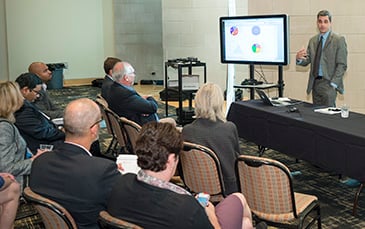Medical students now can use real clinical data to examine patient populations and the value of health care with new, free tools from New York University School of Medicine.
NYU used publicly available, open clinical data sets and local data from NYU Langone Medical Center’s electronic health records (EHR) to develop two new educational clinical data tools. Marc Triola, MD, director of the Institute for Innovations in Med Education at NYU and associate dean of educational informatics presented the tools at a special consortium meeting of 11 medical schools that received AMA grants as part of the AMA’s Accelerating Change in Medical Education initiative. The schools met at Vanderbilt University in September to discuss the progress they’re making in preparing tomorrow’s physicians for the rapid changes in medicine.
NYU used real clinical data from the New York State Department of Health Statewide Planning and Research Cooperative System (SPARCS)—more than 2.5 million patient-level records that include every inpatient discharge from 226 hospitals in New York—to create an interactive website.
Students can sift through diagnosis-related group codes, providers or hospitals to answer a variety of questions. For example, a student could investigate whether severity of illness correlated with length-of-stay for patients with drug and alcohol dependence, or how much charges vary across hospitals for the same payer and a given diagnosis-related code.
“We didn’t want to tell our students what they had to ask—if students were passionate about adolescent medicine or substance abuse or different types of surgeries, they could follow whatever path they wanted,” said Dr. Triola. “This instantly inspires students to want to delve deeper, and it means something to them because they know these hospitals.”
The school also created a simulated health care group that consists of three different types of practices. Combining de-identified data from NYU Langone Medical Center’s EHR, payer and demographic information from SPARCS, patient level lab data and more.
Once students become familiar with the practice group, they complete an exercise: If they worked in this practice group, what quality improvement project would they propose for a $1 million grant?
“It’s incredibly powerful stuff,” Dr. Triola said. “The students are thrilled because it’s real data—it’s not an exercise, it’s not their biostats textbook. It is authentic clinical data and it allows them to really follow their own personal interests.”
Dr. Triola is working with the AMA and the Accelerating Change in Medical Education consortium schools to potentially adapt the tools for use at additional schools. The school is looking for more public data sources to expand the tools in the future.
This post is the second in a brief series on new medical education technology to be published at AMA Wire® over the coming weeks. See the first post at AMA Wire.




